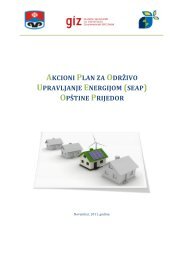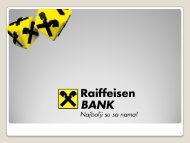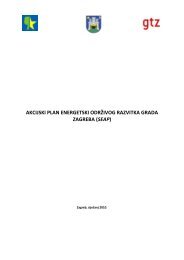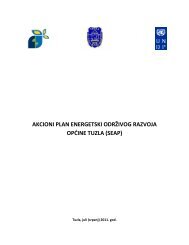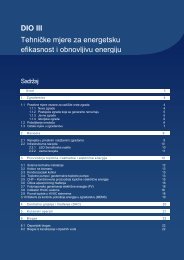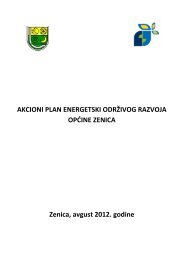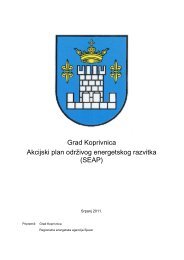TUZLA SEAP – ZGRADARSTVO - Sustainable Energy BiH
TUZLA SEAP – ZGRADARSTVO - Sustainable Energy BiH
TUZLA SEAP – ZGRADARSTVO - Sustainable Energy BiH
- No tags were found...
Create successful ePaper yourself
Turn your PDF publications into a flip-book with our unique Google optimized e-Paper software.
[22]. Similarly, simple spatial searches are well-supported by today’s geographic information systems([29], [30], e.g.). Content-based retrieval of visual data is still in its infancy. Although a few specializedcommercial applications exist (such as fingerprint matching systems), most content-based image retrievalsystems are university and research prototypes. Examples include [20], [ 121, and [24]. Further, with the exceptionof simple approaches like attacbing attributes to spatial objects, or associating user-provided keywordswith images, these component search technologies remain largely isolated from one another.In the database community, much research has been done in the area of heterogeneous distributed databasesystems (also known as multidatabase systems). These systems aim to enable applications that span multipleDBMS. Surveys of the relevant work can be found in [7] and [lo]. Commercial middleware products nowexist for providing uniform access to data in multiple databases, relational and otherwise, and to structuredfiles, usually through the provision of a unified relational schema Models with objed-onented feaaueShave been employed in projects such as (21],[5],(81 and others. What distinguishes Garlic from these effortsis its focus on providing an object-oriented view of data residing not only in databases and recordbasedfiles, but also in a wide variety of media-specific data repositories with spwialized seazch facilities.With the exception of the Papyrus [q and Pegasus [23] projects at HP Labs, we are aware of no othex effortsthat have tried to address the problems involved in supporting heterogeneous, multimedia applications.3 Garlic OverviewFigure 1 depicts the overall architecture of the Garlic system[4]. At the leaves of the figure are a number ofdata repositories containing the data that Garlic is intended to integrate. Examples of potential data repsitonesinclude relational and non-relational database systems, file systems, document managers, image managers,and video servers. Repositories will vary widely in their ability to support content-based search, froma video servex which can simply retrieve by video name, to a relational DBMS with its powerful query language.While Garlic will accommodate (i.e., provide access to) more limited servers, we are particularlyinterested in enabling a richer style of query for a broader range of datatypes. Thus we focus on repositoriesthat provide content-based querying of multimedia datatypes, and on the technology needed to incorporatethem into Garlic, in such a way as to exploit their special abilities.One special repository shown in Figure 1 is the Garlic complex object repository. ?his repository, providedwith Garlic, is used to hold the complex objects that most Garlic applications need to relate together legacyinformation firom different systems, or to create new multimedia objects. For example, an advertising agencythat had infomation about its clients in a relational database, stills of ads in an image server, video clipson a video server and financial reports in a document manager might build Garlic complex objects representingthe ad campaigns to link all of this information together.Above each repository is a repository wrapper. A repository wrapper serves two purposes. First, it exportsto Garlic a description of the data types and collections of data that live in that underlying repository. Thisdescription is basically a schema for that repository instance , expressed in the Garlic Data Model [4] (a vafiantof the ODMG-93 object model 131). It also &scribes to Garlic the search capabilities of this repositorytype - what predicates it supports. Second. the wrapper translates data access and manipulation requests(i-e., queries) from Garlic’s internal protocols to the repository’s native protocol. Initially, wrappen willhave to be created by hand; eventually, we plan to provide tools to ease the task of wrapper generationQuery processing and data manipulation services, especially for queries where the target data resides in ”’3



